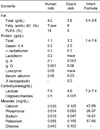Abstract
Breastfeeding provided by healthy and well-nourished mothers is considered the ideal nourishment for healthy term infants and is believed to cover the infant's nutrient requirements during the first 6 months of life. Breast milk composition varies with time postpartum, during nursing, and with maternal nutrition. The changes of human milk composition with time of lactation seem to match the changing needs of growing infant over time. At a certain age, however, breast milk alone no longer can supply all of the infant's nutritional requirements, and complementary foods and/or supplementation of nutrients are needed to ensure adequate nutrition and growth. The nutritional status of lactating mothers is an important health issue since their nutrition status may influence the nutrient concentration of breast milk, while maintaining the nutrients in the breast milk further depletes their own body store. This review discusses the contribution of breast milk to nutritional needs during infancy, growth patterns of breastfed infants, and recommendations regarding the use of complementary foods and nutrient supplementation. In addition, we also review the effect of maternal nutrition on breastfeeding and the nutritional recommendation for lactating women.
References
1. Kunz C, Rodriuez-Palmero M, Koletzko B, Jensen R. Nutritional and biochemical properties of human milk, Part I. Clin Perinatol. 1999. 26:307–333.

2. Rodriuez-Palmero M, Koletzko B, Kunz C, Jensen R. Nutritional and biochemical properties of human milk: II. Clin Perinatol. 1999. 26:335–359.

3. Dewey KG. nutrition, growth, and complementary feeding if the breastfed infant. Pediatr Clin North Am. 2001. 48:87–104.
4. Greer FR. Do breastfed infants need supplemental vitamins? Pediatr Clin North Am. 2001. 48:415–423.

5. Ben XM. Nutritional management of newborn infants: Practical guidelines. World J Gastroenterol. 2008. 14:6133–6139.

6. Leung AKC, Sauve RS. Breast is best for babies. J Natl Med Assoc. 2005. 97:1010–1019.
7. Prentice A. Constituents of human milk. Food & Nutr Bulletin. 1996. 17. (www.unu.edu/unupress/food/8F174E04.htm).

8. ESPGHAN Committee on Nutrition. Agostoni C, Braegger C, Decsi T, Kolacek S, Koletzko B, Michaelsen KF, Mihatsch W, Moreno LA, Puntis J, Shamir R, Szaiewska H, Turck D, Goudoever JV. Breast-feeding: a commentary by the ESPGHAN committee on nutrition. J Pediatr Gastroenterol Nutr. 2009. 49:112–125.

9. Dupont C. Protein requirements during the first year of life. Am J Clin Nutr. 2003. 77:1544S–1549S.

10. Reilly JJ, Wells JC. Duration of exclusive breast-feeding: introduction of complementary feeding may be necessary before 6 months of age. Br J Nutr. 2005. 94:869–872.

11. Krebs NF, Hanbidge KM. Complementary feeding: clinically relevant factors affecting timing and composition. Am J Clin Nutr. 2007. 85:639S–645S.

12. Fewtrell MS, Morgan JB, Duggan C, Gunnlaugsson G, Hibberd PL, Lucas A, Kleinman RE. Optimal duration of exclusive breastfeeding: what is the evidence to support current recommendations? Am J Clin Nutr. 2007. 85:635S–638S.

13. Butte NF, Stuebe A. Patient information: Maternal health and nutrition during breastfeeding. UpToDate. 2008. (www.uptodate.com).
14. Lyn S, Khan P. Maternal nutrition during breastfeeding. La Leche League International. 2004. (http://www.llli.org).
15. Wagner CL, Greer FR, Section on. Prevention of rickets and vitamin D deficiency in infants, children, and adolescents. Pediatrics. 2008. 122:1142–1152.

16. Krebs NF. Food choices to meet nutritional needs of breast-fed infants and toddlers on mixed diets. J Nutr. 2007. 137:511S–517S.

17. Krebs NF, Reidinger CJ, Hartly S, Robertson AD, Hambidge KM. Zinc supplementation during lactation: effect on maternal status and milk zinc concentration. Am J Clin Nutr. 1995. 61:1030–1036.

18. Sian L, Krebs NF, Westcott JE, Fengliang L, Tong L, Miller LV, Sonko B, Hambidge M. Zinc homeostasis during lactation in a population with a low zinc intake. Am J Clin Nutr. 2002. 75:99–103.

19. Nakamori M, Ninh NX, Isomura H, Yoshike N, Hien VTT, Nubg BT, Nhien NV, Nakano T, Khan NC, Yamamoto S. Nutritional status of lactating mothers and their breast milk concentration of iron, zinc and copper in rural Vietnam. J Nutr Sci Vitaminol. 2009. 51:338–345.

20. Mohammad MA, Sunehag AL, Haymond MW. Effect of dietary macronutrient composition under moderate hypocaloric intake on maternal adaptation during lactation. Am J Clin Nutr. 2009. 89:1821–1827.

21. Lonnerdal B. Effects of maternal dietary intake on human milk composition. J Nutr. 1986. 116:499–513.

22. World Health Organization. Fifth fourth World Health Assembly global strategy for infant and young child feeding: the optimal duration of exclusive beastfeeding. 2001. Geneva, Switzerland: World Health Organization.
23. World Health Organization. Complementary feeding: family foods for breastfed children. 2000. WHO/NHD/00.1; WHO/FCH/CAH/00.6 ed. Geneva: World Health Organization.




 PDF
PDF ePub
ePub Citation
Citation Print
Print





 XML Download
XML Download